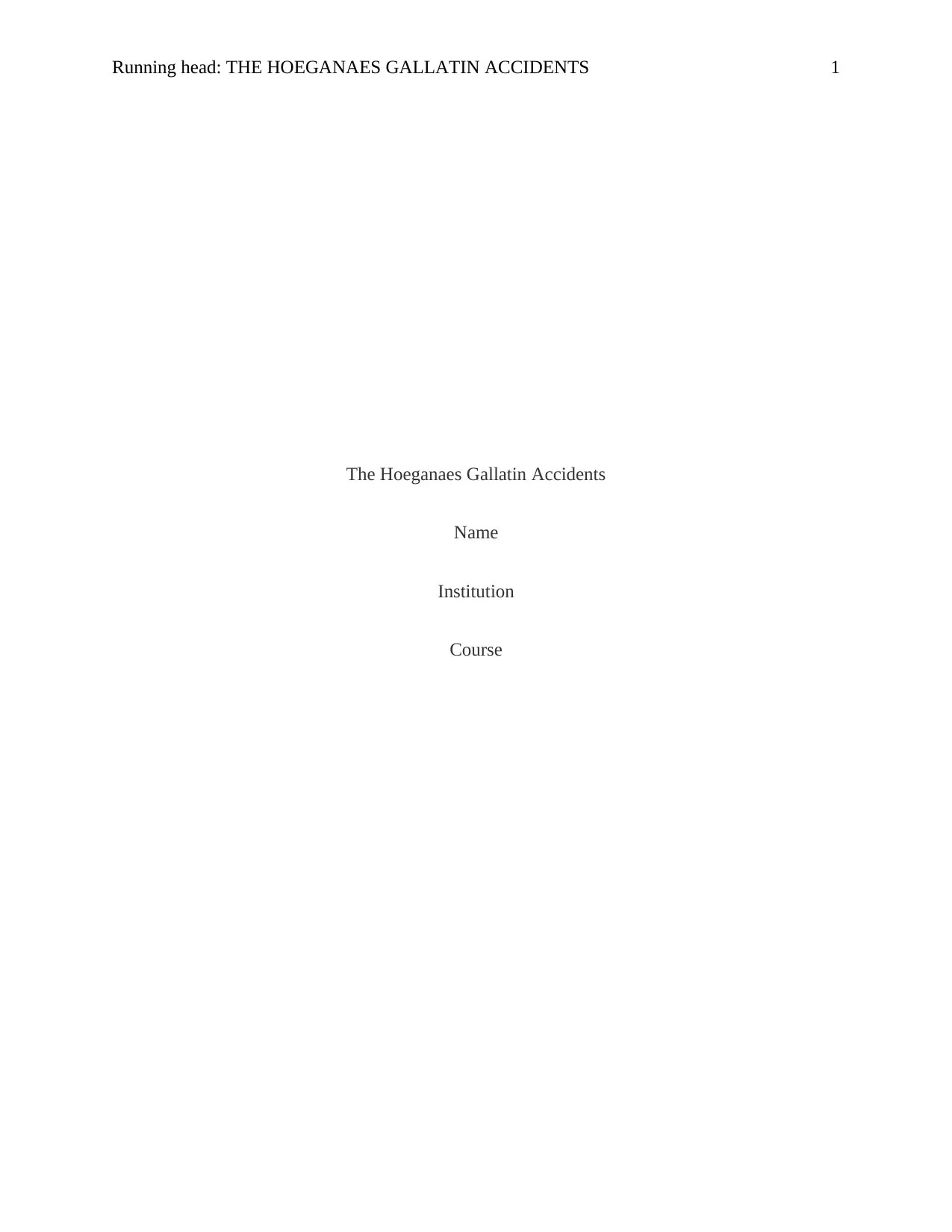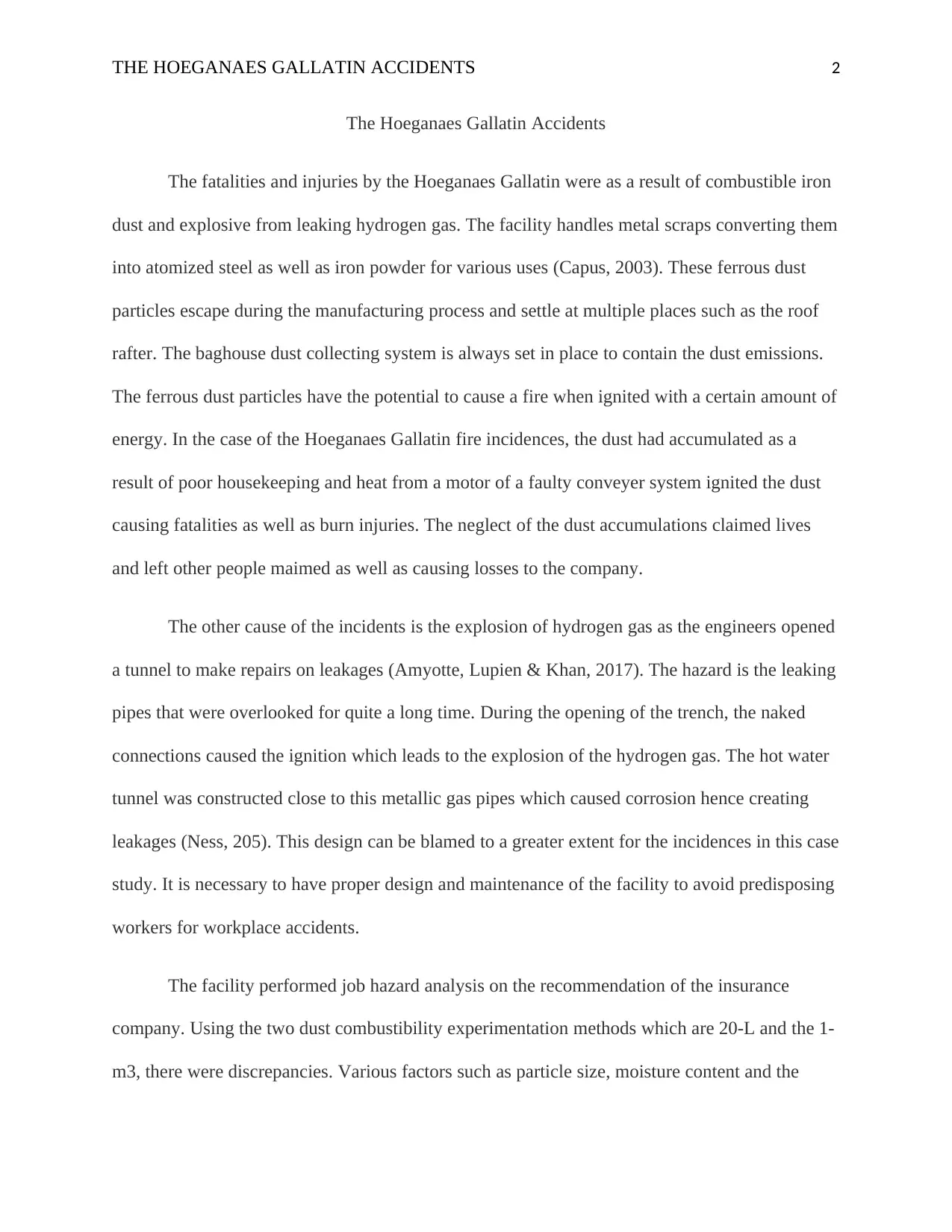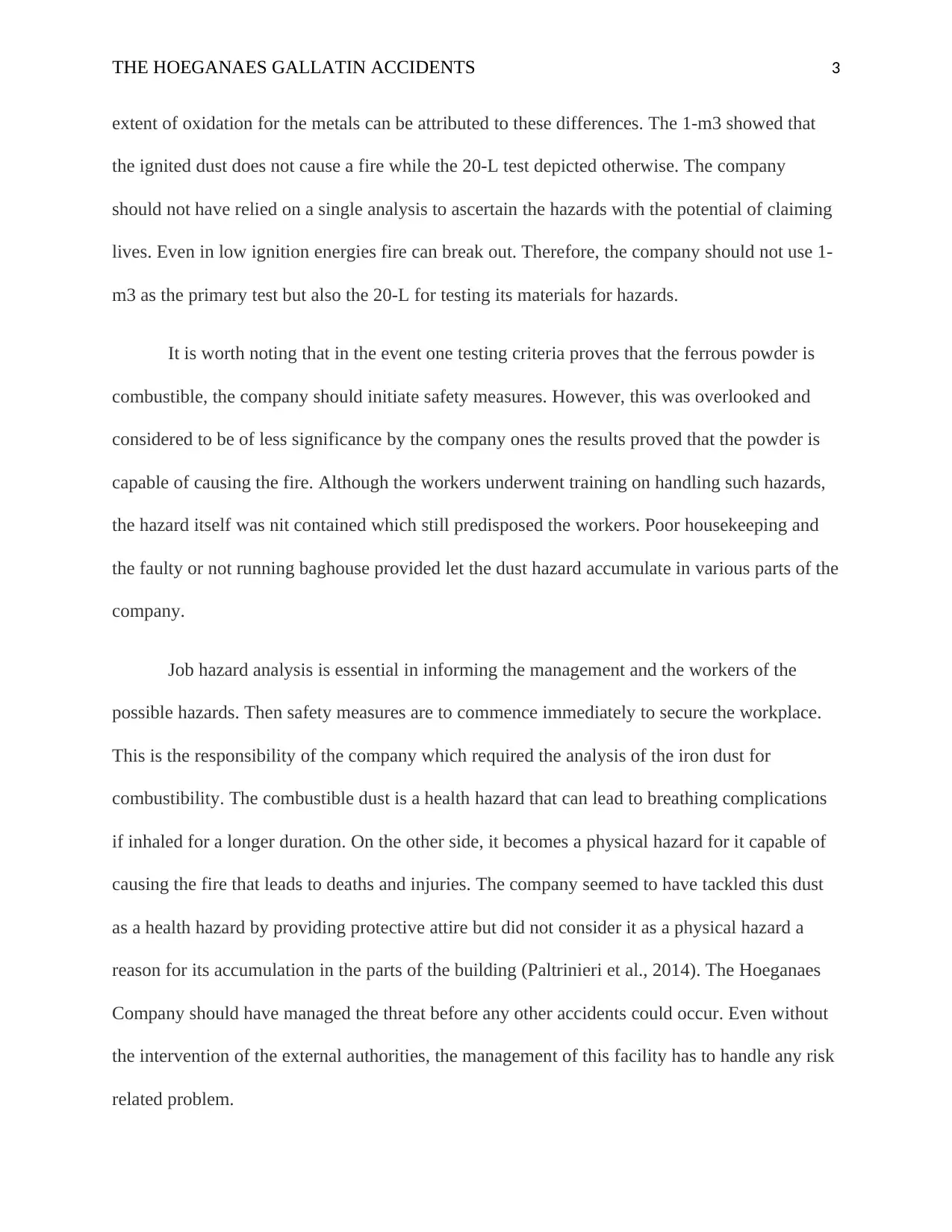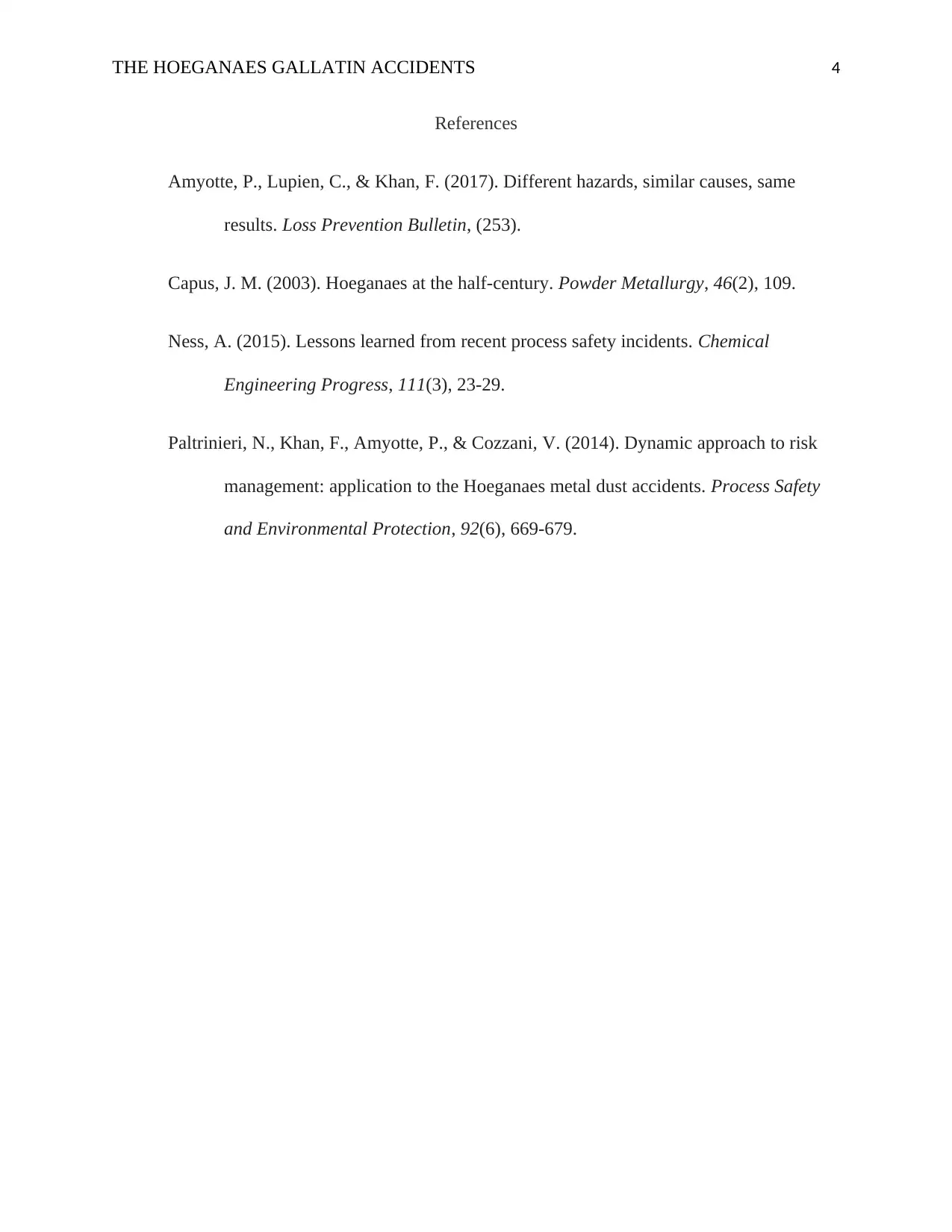The Hoeganaes Gallatin Accidents
VerifiedAdded on 2023/05/29
|4
|863
|82
AI Summary
The Hoeganaes Gallatin accidents were caused by combustible iron dust and hydrogen gas explosion. Neglect of dust accumulations and faulty design were the main causes. Job hazard analysis is essential in informing the management and workers of possible hazards. The company should have managed the threat before any other accidents could occur.
Contribute Materials
Your contribution can guide someone’s learning journey. Share your
documents today.

Running head: THE HOEGANAES GALLATIN ACCIDENTS 1
The Hoeganaes Gallatin Accidents
Name
Institution
Course
The Hoeganaes Gallatin Accidents
Name
Institution
Course
Secure Best Marks with AI Grader
Need help grading? Try our AI Grader for instant feedback on your assignments.

THE HOEGANAES GALLATIN ACCIDENTS 2
The Hoeganaes Gallatin Accidents
The fatalities and injuries by the Hoeganaes Gallatin were as a result of combustible iron
dust and explosive from leaking hydrogen gas. The facility handles metal scraps converting them
into atomized steel as well as iron powder for various uses (Capus, 2003). These ferrous dust
particles escape during the manufacturing process and settle at multiple places such as the roof
rafter. The baghouse dust collecting system is always set in place to contain the dust emissions.
The ferrous dust particles have the potential to cause a fire when ignited with a certain amount of
energy. In the case of the Hoeganaes Gallatin fire incidences, the dust had accumulated as a
result of poor housekeeping and heat from a motor of a faulty conveyer system ignited the dust
causing fatalities as well as burn injuries. The neglect of the dust accumulations claimed lives
and left other people maimed as well as causing losses to the company.
The other cause of the incidents is the explosion of hydrogen gas as the engineers opened
a tunnel to make repairs on leakages (Amyotte, Lupien & Khan, 2017). The hazard is the leaking
pipes that were overlooked for quite a long time. During the opening of the trench, the naked
connections caused the ignition which leads to the explosion of the hydrogen gas. The hot water
tunnel was constructed close to this metallic gas pipes which caused corrosion hence creating
leakages (Ness, 205). This design can be blamed to a greater extent for the incidences in this case
study. It is necessary to have proper design and maintenance of the facility to avoid predisposing
workers for workplace accidents.
The facility performed job hazard analysis on the recommendation of the insurance
company. Using the two dust combustibility experimentation methods which are 20-L and the 1-
m3, there were discrepancies. Various factors such as particle size, moisture content and the
The Hoeganaes Gallatin Accidents
The fatalities and injuries by the Hoeganaes Gallatin were as a result of combustible iron
dust and explosive from leaking hydrogen gas. The facility handles metal scraps converting them
into atomized steel as well as iron powder for various uses (Capus, 2003). These ferrous dust
particles escape during the manufacturing process and settle at multiple places such as the roof
rafter. The baghouse dust collecting system is always set in place to contain the dust emissions.
The ferrous dust particles have the potential to cause a fire when ignited with a certain amount of
energy. In the case of the Hoeganaes Gallatin fire incidences, the dust had accumulated as a
result of poor housekeeping and heat from a motor of a faulty conveyer system ignited the dust
causing fatalities as well as burn injuries. The neglect of the dust accumulations claimed lives
and left other people maimed as well as causing losses to the company.
The other cause of the incidents is the explosion of hydrogen gas as the engineers opened
a tunnel to make repairs on leakages (Amyotte, Lupien & Khan, 2017). The hazard is the leaking
pipes that were overlooked for quite a long time. During the opening of the trench, the naked
connections caused the ignition which leads to the explosion of the hydrogen gas. The hot water
tunnel was constructed close to this metallic gas pipes which caused corrosion hence creating
leakages (Ness, 205). This design can be blamed to a greater extent for the incidences in this case
study. It is necessary to have proper design and maintenance of the facility to avoid predisposing
workers for workplace accidents.
The facility performed job hazard analysis on the recommendation of the insurance
company. Using the two dust combustibility experimentation methods which are 20-L and the 1-
m3, there were discrepancies. Various factors such as particle size, moisture content and the

THE HOEGANAES GALLATIN ACCIDENTS 3
extent of oxidation for the metals can be attributed to these differences. The 1-m3 showed that
the ignited dust does not cause a fire while the 20-L test depicted otherwise. The company
should not have relied on a single analysis to ascertain the hazards with the potential of claiming
lives. Even in low ignition energies fire can break out. Therefore, the company should not use 1-
m3 as the primary test but also the 20-L for testing its materials for hazards.
It is worth noting that in the event one testing criteria proves that the ferrous powder is
combustible, the company should initiate safety measures. However, this was overlooked and
considered to be of less significance by the company ones the results proved that the powder is
capable of causing the fire. Although the workers underwent training on handling such hazards,
the hazard itself was nit contained which still predisposed the workers. Poor housekeeping and
the faulty or not running baghouse provided let the dust hazard accumulate in various parts of the
company.
Job hazard analysis is essential in informing the management and the workers of the
possible hazards. Then safety measures are to commence immediately to secure the workplace.
This is the responsibility of the company which required the analysis of the iron dust for
combustibility. The combustible dust is a health hazard that can lead to breathing complications
if inhaled for a longer duration. On the other side, it becomes a physical hazard for it capable of
causing the fire that leads to deaths and injuries. The company seemed to have tackled this dust
as a health hazard by providing protective attire but did not consider it as a physical hazard a
reason for its accumulation in the parts of the building (Paltrinieri et al., 2014). The Hoeganaes
Company should have managed the threat before any other accidents could occur. Even without
the intervention of the external authorities, the management of this facility has to handle any risk
related problem.
extent of oxidation for the metals can be attributed to these differences. The 1-m3 showed that
the ignited dust does not cause a fire while the 20-L test depicted otherwise. The company
should not have relied on a single analysis to ascertain the hazards with the potential of claiming
lives. Even in low ignition energies fire can break out. Therefore, the company should not use 1-
m3 as the primary test but also the 20-L for testing its materials for hazards.
It is worth noting that in the event one testing criteria proves that the ferrous powder is
combustible, the company should initiate safety measures. However, this was overlooked and
considered to be of less significance by the company ones the results proved that the powder is
capable of causing the fire. Although the workers underwent training on handling such hazards,
the hazard itself was nit contained which still predisposed the workers. Poor housekeeping and
the faulty or not running baghouse provided let the dust hazard accumulate in various parts of the
company.
Job hazard analysis is essential in informing the management and the workers of the
possible hazards. Then safety measures are to commence immediately to secure the workplace.
This is the responsibility of the company which required the analysis of the iron dust for
combustibility. The combustible dust is a health hazard that can lead to breathing complications
if inhaled for a longer duration. On the other side, it becomes a physical hazard for it capable of
causing the fire that leads to deaths and injuries. The company seemed to have tackled this dust
as a health hazard by providing protective attire but did not consider it as a physical hazard a
reason for its accumulation in the parts of the building (Paltrinieri et al., 2014). The Hoeganaes
Company should have managed the threat before any other accidents could occur. Even without
the intervention of the external authorities, the management of this facility has to handle any risk
related problem.

THE HOEGANAES GALLATIN ACCIDENTS 4
References
Amyotte, P., Lupien, C., & Khan, F. (2017). Different hazards, similar causes, same
results. Loss Prevention Bulletin, (253).
Capus, J. M. (2003). Hoeganaes at the half-century. Powder Metallurgy, 46(2), 109.
Ness, A. (2015). Lessons learned from recent process safety incidents. Chemical
Engineering Progress, 111(3), 23-29.
Paltrinieri, N., Khan, F., Amyotte, P., & Cozzani, V. (2014). Dynamic approach to risk
management: application to the Hoeganaes metal dust accidents. Process Safety
and Environmental Protection, 92(6), 669-679.
References
Amyotte, P., Lupien, C., & Khan, F. (2017). Different hazards, similar causes, same
results. Loss Prevention Bulletin, (253).
Capus, J. M. (2003). Hoeganaes at the half-century. Powder Metallurgy, 46(2), 109.
Ness, A. (2015). Lessons learned from recent process safety incidents. Chemical
Engineering Progress, 111(3), 23-29.
Paltrinieri, N., Khan, F., Amyotte, P., & Cozzani, V. (2014). Dynamic approach to risk
management: application to the Hoeganaes metal dust accidents. Process Safety
and Environmental Protection, 92(6), 669-679.
1 out of 4
Your All-in-One AI-Powered Toolkit for Academic Success.
+13062052269
info@desklib.com
Available 24*7 on WhatsApp / Email
![[object Object]](/_next/static/media/star-bottom.7253800d.svg)
Unlock your academic potential
© 2024 | Zucol Services PVT LTD | All rights reserved.